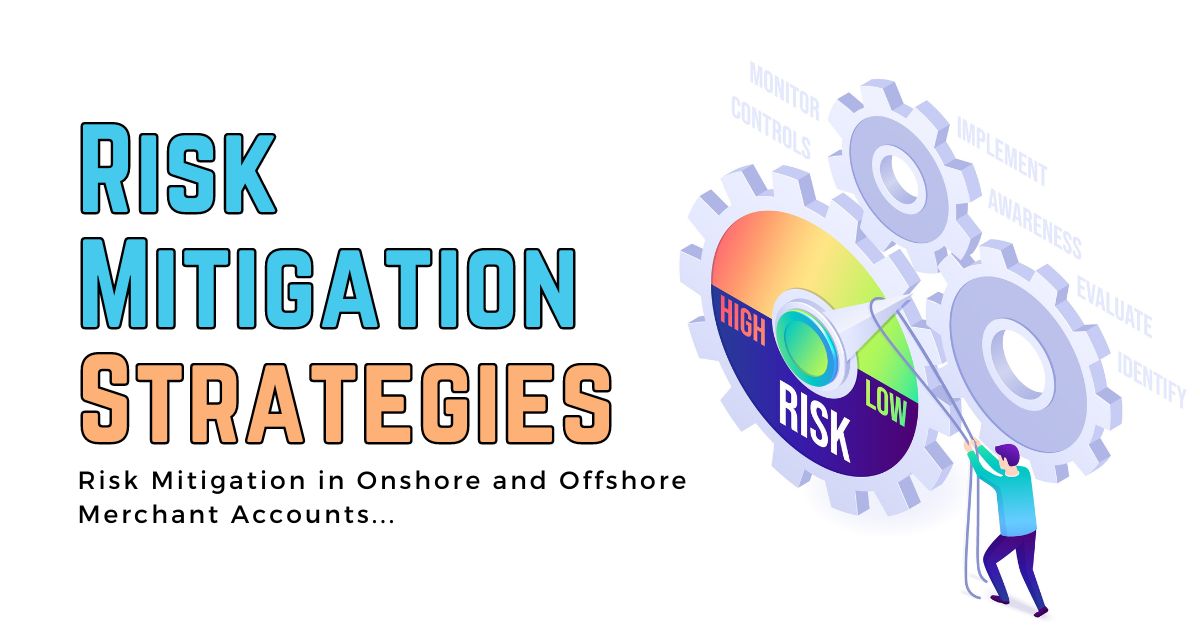
| December 28th, 2023 |
Risk Mitigation Strategies — Balancing Onshore and Offshore Merchant Accounts!
Introduction —
In an increasingly interconnected global economy, businesses are navigating the complex landscape of onshore and offshore merchant accounts to expand their reach and enhance financial operations. While offshore accounts offer potential benefits such as cost savings and access to international markets, they also present unique challenges and risks. This blog explores essential risk mitigation strategies that businesses can employ to strike a balance between onshore and offshore merchant accounts effectively.
Understanding the Risks —
Before delving into mitigation strategies, it’s crucial to identify the inherent risks associated with both onshore and offshore merchant accounts.
Onshore Risks —
- Regulatory Compliance: Strict regulations and compliance requirements vary across different jurisdictions.
- Market Saturation: Intense competition in onshore markets can impact profit margins.
- Economic Volatility: Onshore operations may be susceptible to economic fluctuations and local market conditions.
Offshore Risks —
- Legal and Regulatory Challenges: Different legal frameworks and regulatory environments can pose compliance hurdles.
- Currency Fluctuations: Exposure to multiple currencies can lead to financial uncertainty.
- Operational Issues: Differing time zones and cultural nuances may affect operational efficiency.
Strategies for Risk Mitigation —
To navigate these challenges, businesses need a comprehensive approach that balances the advantages of onshore and offshore merchant accounts. Here are key strategies to consider:
1. Diversification of Merchant Accounts:
Diversifying merchant accounts across onshore and offshore platforms is a fundamental strategy to spread risks and optimize opportunities. This approach reduces reliance on a single market or payment processor, enhancing resilience in the face of unforeseen challenges.
- Geographic Spread: Establishing merchant accounts in diverse geographical regions helps mitigate the impact of localized issues, such as economic downturns or regulatory changes.
- Payment Processor Diversity: Utilizing multiple payment processors ensures continuity in transactions, even if one faces technical issues or disruptions.
2. Thorough Due Diligence and Compliance Measures:
Effective risk mitigation begins with thorough due diligence and adherence to compliance measures. Whether operating onshore or offshore, businesses must stay abreast of regulatory requirements and industry standards.
- Know Your Customer (KYC): Implement robust KYC procedures to verify the identity of clients, reducing the risk of fraudulent activities.
- Regular Compliance Audits: Conduct regular audits to ensure ongoing compliance with local and international regulations, adapting strategies to evolving legal landscapes.
3. Secure Payment Gateway and Data Encryption:
Security is paramount in the world of online transactions. Employing state-of-the-art payment gateways and robust data encryption protocols helps safeguard sensitive customer information and financial transactions.
- Tokenization: Implement tokenization to replace sensitive data with unique identifiers, reducing the risk of data breaches.
- SSL Certificates: Ensure secure data transmission by using Secure Sockets Layer (SSL) certificates for encrypting communication between customers and servers.
4. Dynamic Currency Hedging:
For businesses dealing with multiple currencies in offshore transactions, currency fluctuations pose a significant risk. Dynamic currency hedging strategies can help mitigate these risks.
- Real-time Monitoring: Employ tools and technologies that provide real-time monitoring of currency exchange rates, enabling timely decision-making.
- Forward Contracts: Enter into forward contracts to lock in exchange rates for future transactions, minimizing the impact of currency volatility.
5. Continuous Monitoring and Incident Response Plans:
Staying vigilant and proactive is crucial in risk mitigation. Implementing continuous monitoring systems and having well-defined incident response plans can mitigate the impact of unforeseen events.
- Fraud Detection Systems: Utilize advanced fraud detection systems that analyze patterns and anomalies to identify potential fraudulent activities in real time.
- Incident Response Teams: Establish dedicated teams trained to respond promptly and effectively to security incidents, minimizing downtime and financial losses.
6. Cultural Competence and Local Partnerships:
Understanding the local business culture is essential for success in international markets. Developing cultural competence and forming partnerships with local entities can mitigate operational challenges associated with offshore accounts.
- Local Legal Advisors: Engage local legal advisors to navigate complex regulatory landscapes and ensure compliance with local laws.
- Cultural Training: Provide cultural training for staff involved in offshore operations to enhance communication and collaboration.
Conclusion —
Balancing onshore and offshore merchant accounts requires a nuanced approach that incorporates strategic diversification, stringent compliance measures, and robust security protocols. By understanding and mitigating the inherent risks associated with both types of accounts, businesses can optimize their financial operations, expand their global footprint, and thrive in an ever-evolving business environment. The key lies in proactive risk management, continuous adaptation to regulatory changes, and a commitment to the highest standards of security and compliance.
